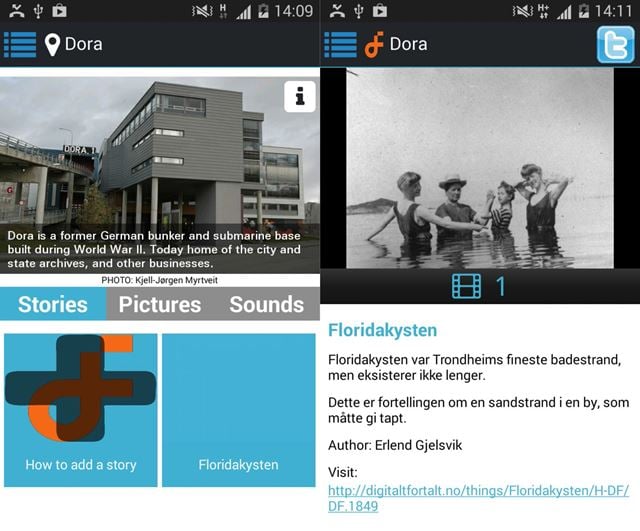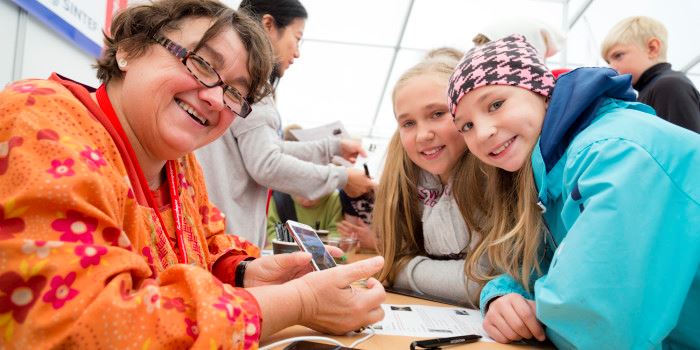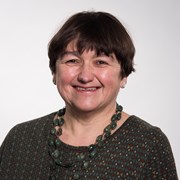“When we had a stand at the “Forskningsdagene” (Research Days) festival recently, we had lots of visits from curious youngsters, families and the elderly who all wanted to see and hear more about the app we call ‘Stedr‘”, says SINTEF researcher Jacqueline Floch.
The app offers exciting stories about local cultural heritage – and you can carry all of them around in your pocket. It also lets you and me upload our own stories about our cultural heritage, architecture, history and music. The app has been developed by SINTEF together with students at NTNU.
Those who visited the stand also became research subjects themselves when we asked them to share their digital habits with the researchers.
“We chatted with many elderly people who thought that hearing the stories was great fun. Some told us many stories of their own”, says Floch, who is the ICT researcher responsible for developing the app.
A European boost for culture
This digital cultural information app has been developed as part of the EU project TAG CLOUD which, among other things, is working with the personally-adapted dissemination of cultural information.
“Only a pitifully small percentage of us visit museums and art exhibitions, or go to history lectures”, says Floch. “But the EU believes that cultural heritage is something that should appeal to more of us. It wants to develop policies that will make more people aware of their heritage. The idea behind the project is to generate a feeling of solidarity and boost our mutual understanding” she explains.
A key element here is that the users themselves contribute by uploading their own audio clips and pictures. In the future the app will be able to make suggestions to the user, in the same way as systems such as Amazone e-learning do today.

This is what the app looks like. Behind the photo of the wartime bunker Dora is the story of a lost sandy beach that people used to call ‘Floridakysten’ (the Florida coast).
Click to open
A new ‘body part’
“Our experience is that cultural heritage and local history inspire people. And this includes children too, especially when they can get the stories via an app on their phones”, says Floch.
“And maybe that isn’t so strange”, she says. “According to the media statisticians at Medienorge, three out of four Norwegians have a smartphone, and six out of ten a tablet. We use our phones for surfing everything from the news to finding out what films are on at the cinema. They’ve become a natural part of our lives – and this means that an app has the potential to become a major channel for the personally-adapted dissemination of cultural information” believes Floch.
The app is linked to countless stories about everything from history, art and architecture to music and more besides. And the stories are just as much about the present day as they are about the past. But what really excites young people is that they can upload their own experiences.
“We’re showing them that there are many different ways to tell a story. You can write it down or make a video”, says Floch. “Or maybe just take a picture or make an audio clip of something going on around you”, she says.
“The ‘Stedr” app gets its stories from the sound repository ‘Digitalt fortalt‘, its pictures from Instagram, and audio clips from SoundCloud”, says Floch. “In the future we’ll be able to gather content from other platforms, such as historical images from the ‘DigitaltMuseum‘ archives”, she explains.
Where is Trondheim’s ‘Florida coast’?
The researchers also arranged a culture quiz for the visitors to our stand called ‘What do you know about your home town?’ This was part of the work to integrate a quiz into the app.
FACTS
TAG CLOUD isn't like Facebook, Twitter or Instagram, but it will incorporate some of the same social elements. The aim is to inspire users to promote their own cultural experiences – to create, add and share information about different buildings, artefacts and sites. Content will gradually become tailored to what people actually think is interesting and exciting.
Three European centres will be taking part in pilot studies:
-
The Barber Institute of Fine Arts is a small art gallery in Birmingham which wants to attract more visitors.
-
The considerably more famous Alhambra Palace in Spain doesn't need more visitors, but would like to offer information in new ways, and connect this to other sightseeing destinations in the region.
-
In Norway, SINTEF is working with the Sør-Trøndelag county authorities to generate interest in culture in the landscape. Trondheim and Rissa are the two locations that have been selected.
Rissa has cultural heritage sites such as Rein Abbey, the ancient rock carvings at Stykket, and many other sites representing different periods in history. Trondheim has any amount of places to choose from – the wharves, Nidaros Cathedral and the Archbishop's Palace. And hundreds more places are listed in the cultural heritage register.
You can read mor aout this here
“We observed that this enthused both children and adults, and even got the whole family involved”, says Floch. “This is why we think it’s a good idea to incorporate a quiz into the app”, she says. Floch recruited many users to test the app during the ‘Forskningsdagene‘ festival.
It is an inspiration, and fascinating too, to know that there are exciting, and maybe also some “secret”, stories out there. There are many examples.
“Just look at this”, says Floch, as she opens the app and displays the answer to the question. “What people used to call the ‘Floridakysten‘ (the Florida coast) was a beautiful white sandy beach now buried by the wartime German bunker called Dora”, she says.
An app for today
“But not everything has to be about the past”, says Floch. “Contemporary culture is also interesting. The app can also connect to stories about music or concerts, and it can communicate with archives such as SoundCloud”, she says, and finds an audio file which she uploaded herself when 8,000 brass band musicians gathered together to play ‘Nidelven Stille og Vakker‘ (Nidelven river, calm and lovely)’ in Trondheim city centre this summer.
“Just how cool is that? It isn’t every day that you can hear 8,000 people playing a single melody all at once”, Floch says, smiling broadly.
Sunday walks may never be the same again.
People who want to be ‘test pilots’ for the app can register using the app’s blog page at http://stedr.blogspot.no/2014/09/hjelp-oss-utvikle-bedre-apper.html


